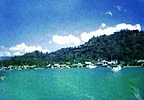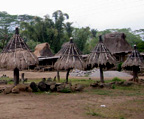|
Mataram and Cakranegara
Mataram is the capital of the province which has in the
past decades joined with Ampenan, the port, and Cakranegara
to become the province's biggest urban complex.At around the beginning
of the 18th century, Mataram was the residence of the crown prince
of Karang Asem, a kingdom in southern Bali.
The ruler himself had his seat in Cakranegara.
The royal palace no longer exists, but many of the old temples and
pleasure gardens are still there. Lombok's biggest Balinese temple
is the Pura Meru in Cakranegara.
Dedicated to the Hindu trinity, Brahma and Vishnu, it
was built in 1720 by Anak Agung Made Karang, which has three
courtyards. Three pagoda like places of worship stand in a line
from north to south in the innermost courtyard. The one on
the north is dedicated to Vishnu and has a roof with nine tiers.
The central is dedicated to Shiva with 11 tiers on its roof and
the southernmost one is for Brahma with a roof of seven tiers. Nearby
is Taman Mayura. once part of the royal palace, it has an artificial
lake set in the middle of a park. A raised path leads from the side
of the pond to a pavilion built in the middle of the lake.
In former, days, justice was meted out and religious rituals were
performed in this open-sided pavilion.
Narmada
Taman Narmada, 11 kilometers east of Mataram, was built
in 1727 by King Anak Agung Gede Ngurah Karang Asem as both a pleasure
garden and place to worship Shiva. Its big pool is said to represent
Segara Anakan, the crater lake on the volcano Rinjani where they
used to make offerings by throwing valuables into the water. As
the became too old to make the pilgrimage up the 3,726 meter high
mountain, he had Narmada made to represent the mountains and the
lake. Near the pond is A place of worship and a spring whose water
is believed to give dedicated pilgrims eternal youth.
Pura lingsar
This may be the only Hindu shrine in the world where both
Hindus and Moslems come to worship. About 7 kilometers west of Narmada,
it was built in 1714 and rebuilt in 1878 to symbolize harmony and
unity between the Hindu Balinese and Moslem Sasak population of
the area, especially those who adhere to Lombok's unique Wektu Telu
school of Islam.
The Balinese temple is built on higher ground, behind the Moslem
section in the compound. In the lower yard is a spring in which
pilgrims in the temple yard stage a mock battle between Hindus and
Moslems in which troth parties hurl rice cakes at each other.
Pura Agung Gunung Sari
This great temple on a hill at Gunung Sari, about four kilometers
from Mataram, was witness to the Puputan battle to the last man,
fought on November 22, 1894, between Lombok's last Balinese ruler,
Anak Agung Nengah and followers, and the Dutch troops under General
Van der Vetter's command.
Sukarare
This is a village of weavers south of Cakranegara. Lombok
is known for its brightly Patterned songket cloth. People have been
making it on their handlooms for many generations.
Sengkol, Pujut and Rambitan
Time seems to have frozen in these three villages in southern
Lombok on the road from the capital to Kuta Beach. All the houses
and barns are built in the age- old traditional style where life
itself appears to be as it always has been. The arid savanna-like
landscape of this area is impressive even in its starkness.
Batu Bolong Beach
Located 9 km from dowtown Mataram, this beach has a huge
rock with a hole in it. A Hindu temple lies on top facing the Lombok
Strait and across is the contour of ma jestic Mount Agung of Bali.
after sunbathing, relaxing and frolicking on this beautiful beachfront,
try to stay till the end of the day to watch one of the most stunning
sunsets you have ever seen when the sun slowly begins to disappear
behind Mount Agung with incredibly flaming colours.
Taman Mayura
The Mayura Park is what remains of the once existing Karang
Asam kingdom of Bali whose King A.A. Ngurah built it in 1744.
In the middle of a large pond is a structure called Balai Kambang
which at the time functioned as a legal court of justice as well
as a hall for important meetings. Curiously, its architecture shows
both Hindu as well as Islamic influence, whereas around the place
statues made of stone are found in the form of a Moslem hajji
Pura Meru
Another relic remaining from the Karang Asam Kingdom is
the Meru Temple at Cakranegara, close to Mataram. The temple was
built in 1720 during King A.A. Made's rule as a symbol of Hindu
unity on Lombok island. Several structures are found in this complex,
all of them designated to function for particular pur poses, including
the 33 stalls located next to the main temple.
Kuta Beach
Also known as Putri Nyale Beach, Kuta on the south coast
of central Lombok is one of the most scenic and unspoilt beaches
in this part of Indonesia. From Kuta to Tanjung Aan five km away,
it is an unbroken stretch of clean white sand on the Indian Ocean.
It is safe for bathing and swimming. Further to the west are the
surfers and windsurfers beaches. Each year, on the 1 9th day of
the tenth month of the Sasak lunar calendar when the Nyale fish
come to the sea's surface, Kuta Beach is the site of great festivities.
Fishermen sail out to sea while young men and women gather along
the teach to join in the merrymaking, tease each other and perhaps
meet to build a more lasting relationship.
Gili Air, Gili Meno and Gili Trawangan
Gili, in Sasak means "island". These three are
clustered together just off the northwest coast of Lombok. Coral
gardens abound in clear waters around the islands. Gili Air, the
nearest island, can be reached in 10 to 15 minutes by outrigger
boat from Bangsal harbour, near Pamenang.
Senggigi Beach
Senggigi, north of Bangsal, belongs to the most scenic and
most popular beaches an the island of Lombok with good accommodation
facilities. Coral gardens grow in the sea just off shore.
Mount Rinjani
Mount Rinjani, a 3,726 meter high active volcano, is one
of the tallest mountains of Indonesia. At the floor of the volcano's
huge caldera is the sickle shaped crater lake Segara Anakan, surrounded
by steep walls. The mountain is popular with hikers. Sembalun Bumbung
and Sembalun Lawang are two traditional Sasak villages on the slopes
of Rinjani.
Tepas, Sumbawa
A village on the slope of the mountain Batu Lante, 60 kilometers
south of Sumbawa Besar, where the houses are built in traditional
architectural style.
Mount Tambora, Sumbawa
Not active at present, the 2,820 meters tall volcano Tambora
i. notorious for its savage eruption on April 5 -July 15, 1815.
Falling debris, hot gases and lava streams killed more than 12,000
people. Some 44,000 more perished of hunger in the aftermath of
the explosion. The top, now a big caldera has two colored lakes.
From the rim of the crater, the view on the rest the island, the
sea, Mt. Rinjani, and the island of Lombok in the distance is breathtaking.
The mountain occupies almost the entire Sanggar peninsula.
Moyo Island
Moyo Island, at the mouth of the Bay of Saleh, has a nature
reserve with wild oxen, deer, wild boars and a great variety bird
species. Visits are best made during the dry season from
June through August.
Bima, Sumbawa
The former palace the Bima sultanate. The building is now
being turned into a museum. Dara s village two kilometers from the
town of Bima in eastern Sumbawa, is belieaves to have been the seat
of the anchient Bim kingdom.
Sape, Sumbawa
Ship wrights still make sailboats the traditional way in this port
town on Sumbawa's east coast. Sape is a convenient point of departure
for trips to Komodo Island across the strait, home of the prehistoric
Komodo lizard.
Beaches
Other good beaches are found at Talolai and Hangawera, north
of Bima, Lunyuk on the south coast of Sumbawa.
Hu'u Beach
(Dompu Regency)
Beautiful beach with white sand located on the Indian Ocean.
It is known for its big and long waves which is good for surfing.
The beach surrounded by lovely panorama, mountains and for 3 est.
The distance from Dompu | is 37 km, can be reached by car and has
modest accommodation for visitors.
Ule Beach
(Bima Regency)
A calm beach with white sand nicely located on the Bima
bay with a beautiful small island called Pulau Kambing (island of
goat). There are fish ponds and garoso trees (tropical fruit trees)
along the beach.
A popular recreation sport of the local people.
Wane Beach
(Bina Regency)
Located 60 km from Bima and be reached by car. It has white
sand and big wave whichis suitable for surfing.
|



















